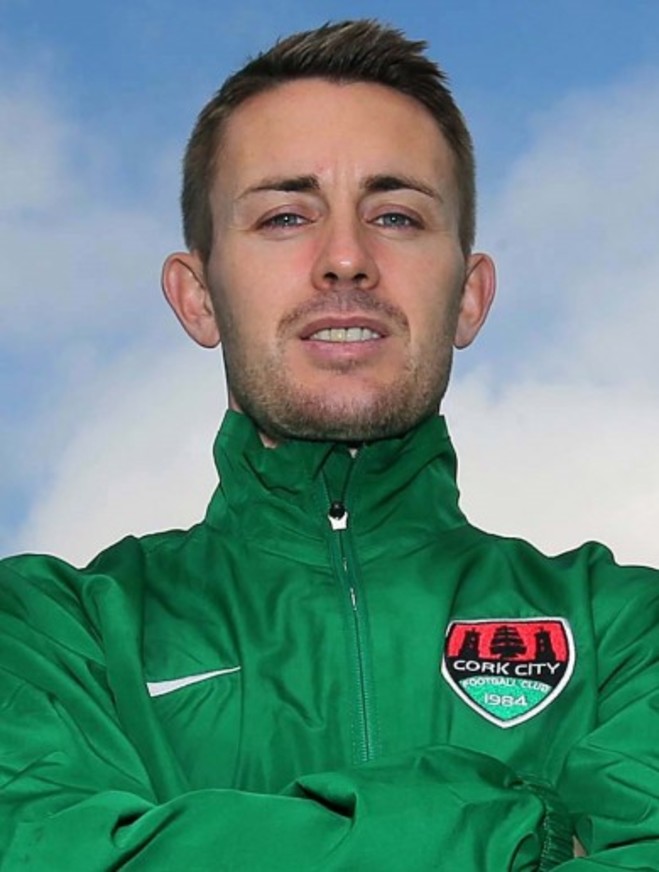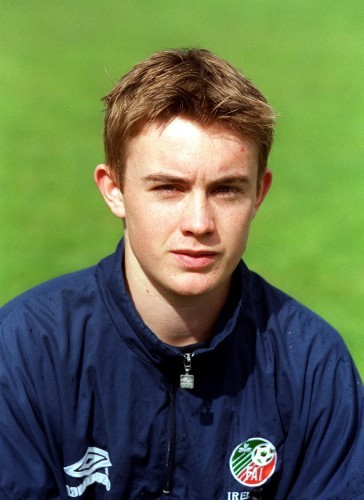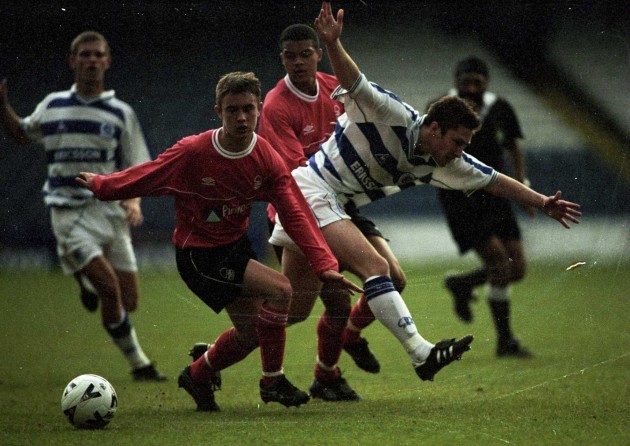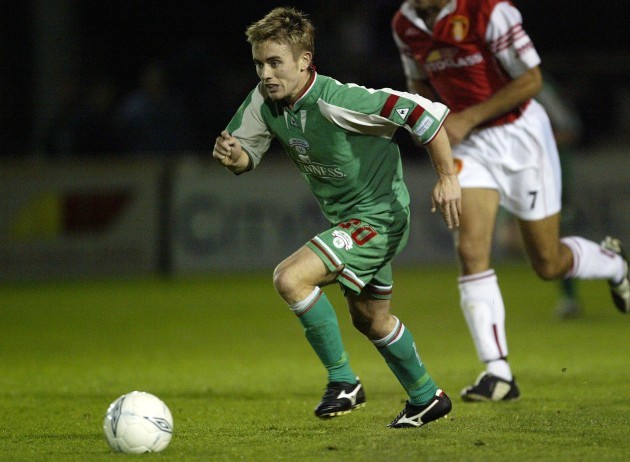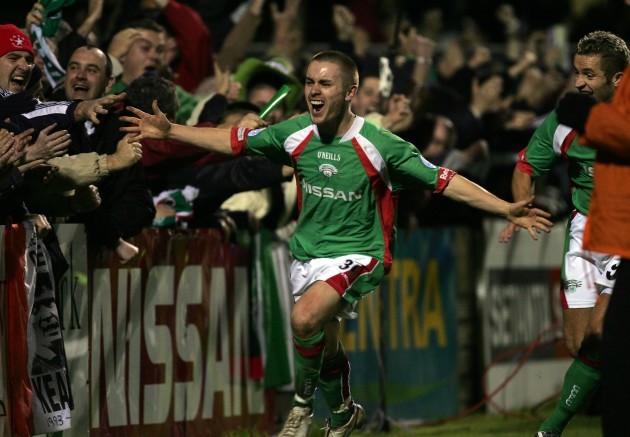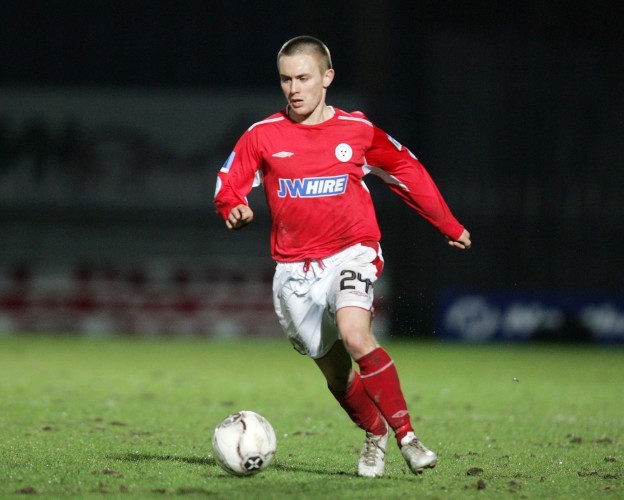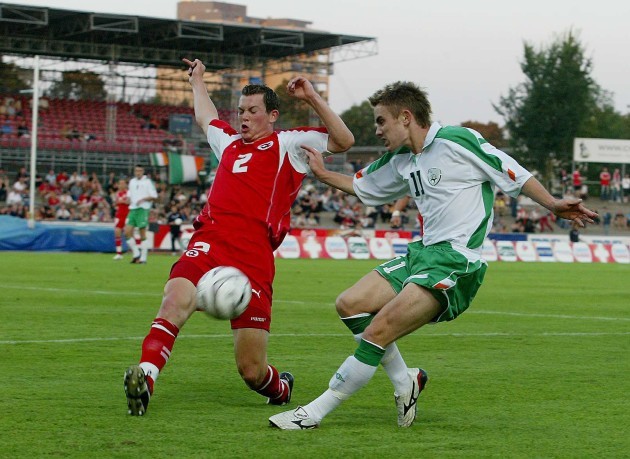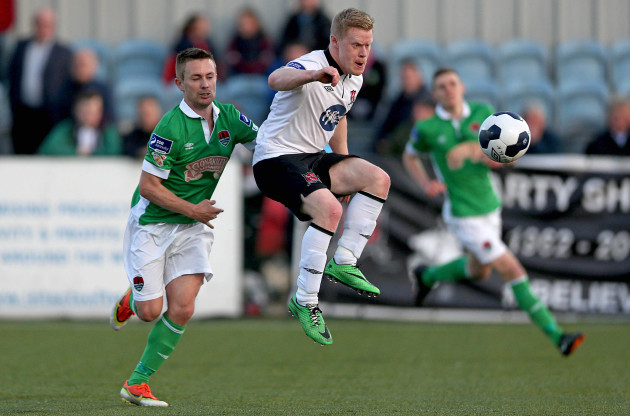AT THE END of the club’s league-winning season in 2005, if you were asked which Cork City player would be most likely to perform a heel-turn by switching allegiances to their fiercest rivals, Liam Kearney would probably have been at the bottom of the list.
Born and bred in the East Cork village of Conna, Kearney personified everything the supporters at Turner’s Cross wanted in their ideal player. Proud and passionate when he wore the shirt, the winger had a swagger to his game too — which earned him the ‘Conna Maradona’ moniker.
Kearney also had a point to prove. At 16, he followed in the footsteps of Cork’s most famous footballing son by joining Nottingham Forest. When it didn’t work out for him in England, he returned to Cork and sought to kickstart his professional career closer to home. But most importantly for City fans, he was from Cork.
“Hurling was probably the big thing for me growing up, so when I ended up playing for Cork City I probably saw it as the soccer equivalent of playing senior for my county,” Kearney says. “The pride I felt was unreal.”
When Kearney moved to Nottingham in 1999, Cork hurling was on its way back after what had been a mostly difficult decade. The Rebels began ’99 as reigning All-Ireland champions at U21 and minor level, and ended it with their first senior title in nine years.
In Conna, a village of fewer than 300 people and home of the St Catherine’s club, hurling reigned supreme. Catherine’s had been promoted to the senior ranks in Cork for the first time in 1994, going on to reach a quarter-final in ’98. Kearney was earmarked as the type of player who could eventually turn them into legitimate championship contenders.
His performances as a corner-forward for Cork’s underage teams earned him comparisons to Seanie McGrath and Joe Deane. He was joined in the full-forward line by Setanta O hAilpín and Tomás O’Leary — two players who’d also go on to discover what it was like to drop hurling in favour of another sport.
“It was very hard to leave hurling behind,” Kearney admits. “When the chairman of the club heard that I had a chance to go to England, he said to my dad: ‘You need to have a chat with him’. That was the mentality. Because of where I was from, soccer was always a secondary thing.
“I’ll never forget the last game of hurling I ever played. I cried at half-time because I was taken off. The coach said the team had to move on and adjust without me so they decided to start right away. I was gutted because I knew that I’d probably never pick up a hurley again.”
Roy Keane had raised the bar high for Corkonians at Nottingham Forest by the time Kearney and Paul Fenton from Ballincollig went to the East Midlands. Kearney was coached by Paul Hart in academy teams that featured Jermaine Jenas, Andy Reid — “one of the most talented players I ever played with” — and Michael Dawson.
He played at left-back on a Forest side that won the U19 Premier League by getting the better of Queens Park Rangers in the final. His opposite number was Danny Murphy, who he’d later link up with on the left flank for Cork City.
Forest released Kearney after he spent four years with the club. There was an opportunity for him to stay in England by impressing at Cambridge United, but injury problems obstructed his plans to take a second bite at the cherry elsewhere.
“Being let go by Forest had been coming,” he says. “I was after having two operations on my ankle. Everyone has a sob story about why it didn’t work out but that definitely didn’t help.
“I played in a trial game for Cambridge against Reading. I was playing in midfield against Steve Sidwell and guys like that. I was actually playing very well, the manager was delighted at half-time, but then I went back out for the second half and ripped the ligaments in my ankle off the bone.”
He adds: “I’d like to have gone further in England but that’s just how it went for me back then. My parents were always supportive but before I went over they were wondering if I’d be better off staying at home and doing my Leaving Cert first — and maybe that would have been the best thing for me.
“It’s a very small rate of fellas who actually make it into a first team. You see loads of guys since — Kevin Doyle, Seamus Coleman, Wes Hoolahan — who have proved themselves in the League of Ireland before going over. First of all, the clubs in England probably have more respect for that, and secondly you’re getting first-team football against men.
“I think that’s a huge advantage to young lads going over. If you go over at 16 without that, you’ll probably spend years in the youth teams and the reserves before you ever get a chance of getting into the first team.
“But you don’t yet have the competitive edge that comes with playing senior football against adults. There is a big difference in that. You’d see the difference between a lad who has played competitively in a senior league and one who has only been playing in the reserves or U19s.
“Coaching has improved here [in Ireland] so much now that you’ll probably get the same footballing education if you stay at home and do your Leaving Cert too. Then if you can get into a first team in the League of Ireland you can put yourself in the shop window. I do think that’s the best option for young Irish lads now.”
After signing for Cork City during the 2003 season, Kearney didn’t take long to endear himself to the home fans. Scoring a debut goal at Turner’s Cross against one of the traditional big clubs from Dublin — defending Premier Division champions Bohemians in this case — has never failed to charm the locals on Leeside.
Kearney quickly established himself as a key player during what transpired to be the most prosperous spell in City’s relatively short history. In 2004 he scored the only goal of an Intertoto Cup tie away to Malmo — arguably the club’s greatest ever European win — and he was also on target in the ’05 league decider against Derry City.
“It was a fairly unique situation at the time where we had so many Cork lads of a similar age who had just come back from England — myself, George O’Callaghan, John O’Flynn, Joe Gamble, for example — and we all had something to prove. It had to work out for us then or it probably never would,” Kearney explains.
“The football we played was probably the most enjoyable of my career. It was almost total freedom to express yourself and that suited us with the kind of players we had. We were never held back by tactics or gameplans or anything like that. It was sad that the group didn’t stay together in the end.”
Despite seeing off Derry and champions Shelbourne to win the club’s first Premier Division title in 12 years, Cork City struggled to keep Damien Richardson’s successful squad intact. Greg O’Halloran moved to Shels after being restricted mostly to substitute appearances under Richardson, while John O’Flynn went on trial at Swansea City. Kearney was in demand too.
He has never used it as an excuse but Kearney admits now that his height — or lack thereof — “maybe” went against him: “I suppose it would be easy for me to say it did but it was something I tried not to make an issue of at the time.”
The Ireland U21 international didn’t shirk the physical side of the game but — at just five-foot-six – he knew he’d be best served by maximising his technical ability and pace instead. It was subsequently no surprise that he excelled in European games against the likes of Nantes, Slavia Prague and NEC Nijmegen.
“If I was brought up in a different footballing culture, like on the continent, it probably would have suited me better,” says Kearney. “I really enjoyed the freedom of the European games. Teams don’t tend to close you down as much and I was probably more of a technical player than anything else. You have to adapt as well though. I had no choice other than to do that in a very physical league in Ireland.”
For that reason, one offer stood out above the rest following the conclusion of the 2005 season. Shortly after City were denied the double by Drogheda United at Lansdowne Road in the FAI Cup final, Kearney was invited to the Netherlands to meet the chairman at high-flying Heerenveen — who had finished fifth in the Eredivisie the previous season.
“I saw it as my dream move,” explains Kearney. “They had [Klaas-Jan] Huntelaar and [Georgios] Samaras up front. The chairman was telling me I’d be the first Irish player they had ever signed and I’d be playing alongside fellas like that. It all sounded unreal. It was a short-term contract but I thought it was a perfect opportunity because if it didn’t work out I could just go back to City, where I was loving my football anyway.”
Although Kearney’s contract with Cork City was at an end, the League of Ireland champions were entitled to compensation if the player moved on as he was still under the age of 23. Agreeing an appropriate fee was down to the two clubs, but they were poles apart in the negotiations. Earlier that year, City received just over €100,000 from Reading for Kevin Doyle and Shane Long. They were determined not to be stung again.
According to Damien Richardson, Heerenveen were only willing to pay €15,000 to secure Kearney’s signature. Richardson said at the time: “As far as I am concerned, Heerenveen have showed little respect for the club or the ability of the player. I am in football long enough to know that a six-month deal is an insult and nothing more than an extended trial. There was no way that I was going to be duped. This is shoddy practice and we won’t tolerate it.”
Deterred by City’s stance, Heerenveen backed out and Kearney was left in limbo. His motivation to leave Cork was born out of a desire to advance his career. Instead he made a move which was fuelled by resentment — and it was one he quickly regretted.
Kearney: “There was a massive conflict between myself and Cork City over it. The club didn’t want to lose me, which I appreciated. But the figure [reported at the time to be €100,000] they came up with was delusional. I knew how much I was probably worth and it was nowhere near that.
“I was heartbroken. I really wanted that Heerenveen move. If it worked out there I felt I’d be back on the path of taking my career further. After seeing the facilities over there and the style of football, all I could think about was how much more of a better player I could become.”
Cork City supporters could have stomached losing Kearney to a big club in one of Europe’s top leagues, but not to another League of Ireland side — and certainly not Shelbourne. The Dublin outfit were looking to regain the title in 2006 and manager Pat Fenlon needed a replacement for Wes Hoolahan, who had signed for Livingston.
“I felt that there was a complete breakdown in the relationship in Cork,” Kearney says. “It was hurtful the way things were handled. City could have handled it better, but I probably could have too. There was stubbornness on both parts and we both lost out in the end.”
The compensation stumbling block meant that Kearney’s proposed move to Shelbourne went to an independent tribunal, which ultimately ruled in favour of the Tolka Park club. City didn’t receive a penny as the 23-year-old departed, but it backfired for both parties.
“In hindsight going to Dublin was a big regret. I knew instantly that I shouldn’t have done it. People will claim that you should never have regrets but the reality is that sometimes you do. City regretted it and I regretted it,” Kearney explains.
“I ended up losing a year of my career in my prime, as well as the chance to play for Cork City in the Champions League. I won the league at Shelbourne but did it mean anything to me? Probably not.”
The backlash from the Cork City following was inevitable, but the extent of it took Kearney by surprise. Assuming that he had left the club for a bigger salary in Dublin, City supporters scanned Kearney’s image onto fake €20 notes and used them as confetti when Shels headed south in April 2006 for his first visit to Turner’s Cross as an opposing player.
“It was hard,” Kearney admits. “The fans don’t know what goes on behind the scenes but in their eyes I had just joined their club’s biggest rivals so things were only ever going to go one way for me. It was understandable.
“People thought I had gone for money but that wasn’t the case. And even if the money was better, is it really worth risking uprooting yourself and compromising your happiness for the sake of an extra hundred quid or whatever? Happiness in the football you’re playing is much more important than happiness with what you’re earning. No League of Ireland player can retire on what they’re being paid so money should never really be a factor at this level.
“There was actually more money on offer in Cork. For me it was just the feeling of frustration and resentment over the way things were handled.”
Kearney started on the bench for that Setanta Sports Cup semi-final at the Cross, which City won 2-0. He was eventually introduced as a substitute to a chorus of jeers, but his contribution was minimal. He was taken aback by the level of hostility, which manifested itself in his ineffective display.
“Absolutely it did,” Kearney insists. “Massively so. Having to get a Garda escort was an interesting experience. My confidence was in bits. I probably wasn’t strong enough at the time to deal with it. It affected me badly. My family were there and all I could think about was the fact that they had to listen to all of this. It was a very difficult time.
“I remember there was a banner in the ground that said, ‘Ticket: €15, Programme: €3, Judas on the bench: Priceless’. I said to Greg [O'Halloran], ‘Why aren’t you getting any of this?’ I never wanted to come out and explain myself because people didn’t want to know. In the fans’ eyes I left them and that’s all there was to it.”
Kearney admits that he never settled in Dublin. He managed just 14 appearances for Shels throughout the 2006 season, during which he also took some time away from the game: “It was down to myself. I wasn’t playing at the level I should have been.”
Home comforts were required. When Shelbourne found themselves facing relegation due to financial turmoil in 2007, the door opened for Kearney to seal a move back to Leeside. To say the supporters welcomed their prodigal son home with open arms wouldn’t quite be accurate, but Kearney rectified that on the pitch by doing what had made him a Cork City fan favourite in the first place.
City won the FAI Cup in his first season back at the club, with Kearney scoring both goals in their 2-0 semi-final win against Bohs at Dalymount Park. The following year he netted the winner in City’s 2-1 victory over Glentoran in the Setanta Sports Cup decider. By the time financial uncertainty at the club forced Kearney to leave for Derry City in 2009, his dalliance with Dublin was long since forgotten in Cork.
“Brian Lennox was the chairman at the time but myself and Brian always chat away now on great terms whenever we meet,” Kearney explains. “Brian is a good guy and all he cared about was doing the best for Cork City, which was admirable from his point of view.
“We just had different objectives which happened to clash at that particular time. It’s been water under the bridge for a long time. I’d like to think that I proved afterwards how much the club means to me.”
Kearney moved from Derry to Waterford United before spending three years in Australia. With the club under the ownership of supporters, he was back for his third spell at Cork City in 2014. Despite being a couple of months shy of his 33rd birthday, Kearney retired at the end of the 2015 season, much of which he spent on the bench. However, the premature end to his playing career has allowed him to get a headstart as a coach.
Kearney: “I knew my days as a player with City were numbered, so where do I go from there? If I didn’t have the hunger to play at City then I definitely wouldn’t have it somewhere else. I see my long-term career in coaching, which will be difficult because it’s a very competitive field, but let’s see where it takes me.”
Having worked for nine months at various levels in North Carolina, Kearney — a Uefa ‘B’ licensed coach — has been appointed first-team coach at Cork City for the 2017 campaign. He takes over from Alan Reynolds to work alongside manager John Caulfield and assistant boss John Cotter.
After three consecutive second-place finishes, City will be looking to win the Premier Division title for the first time since that 2005 triumph. Their bid to halt Dundalk’s dominance begins away to Finn Harps on 24 February. When City last kicked a season off in Ballybofey, they ended it as champions.
“There’s a huge hunger there,” Kearney insists. “There has to be at this stage. A lot of the boys — John Kavanagh, Garry Buckley, even Gearoid Morrissey — are at an age now where there’s no excuses. The confidence should be flowing through them, they have the ability and the mental edge should be there too. If I can help the players and John and Cotts to push on, then that’s something I’ll relish. But we have to hit the ground running.”
Kearney will take his first session tomorrow when the Cork City players begin pre-season training. Having turned 34 earlier this week, he’s younger than some of the players he’ll be barking out the orders to. And while Kearney may have lost the hunger to play, the appetite for success with City is still substantial. Now he’s just travelling a different route in pursuit of it.
“My best performances were for Cork City because it meant more. It probably shouldn’t have because it’s a job at the end of the day and you have to be at your best no matter where you are. But that’s just a fact. Representing Cork always brought the best out of me as a player.”
If the same can be said of Kearney the coach, perhaps 2017 will be the year when second-best will no longer have to suffice at Turner’s Cross.
